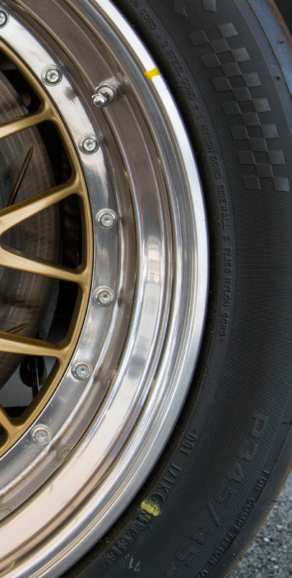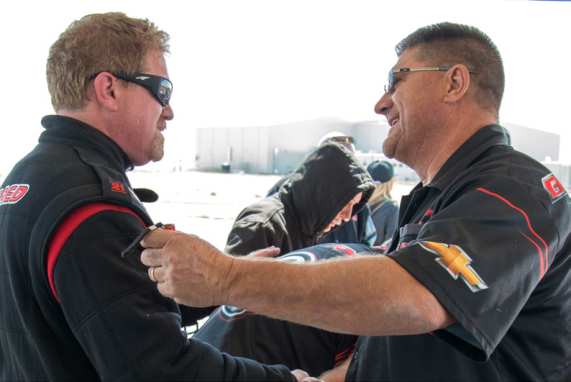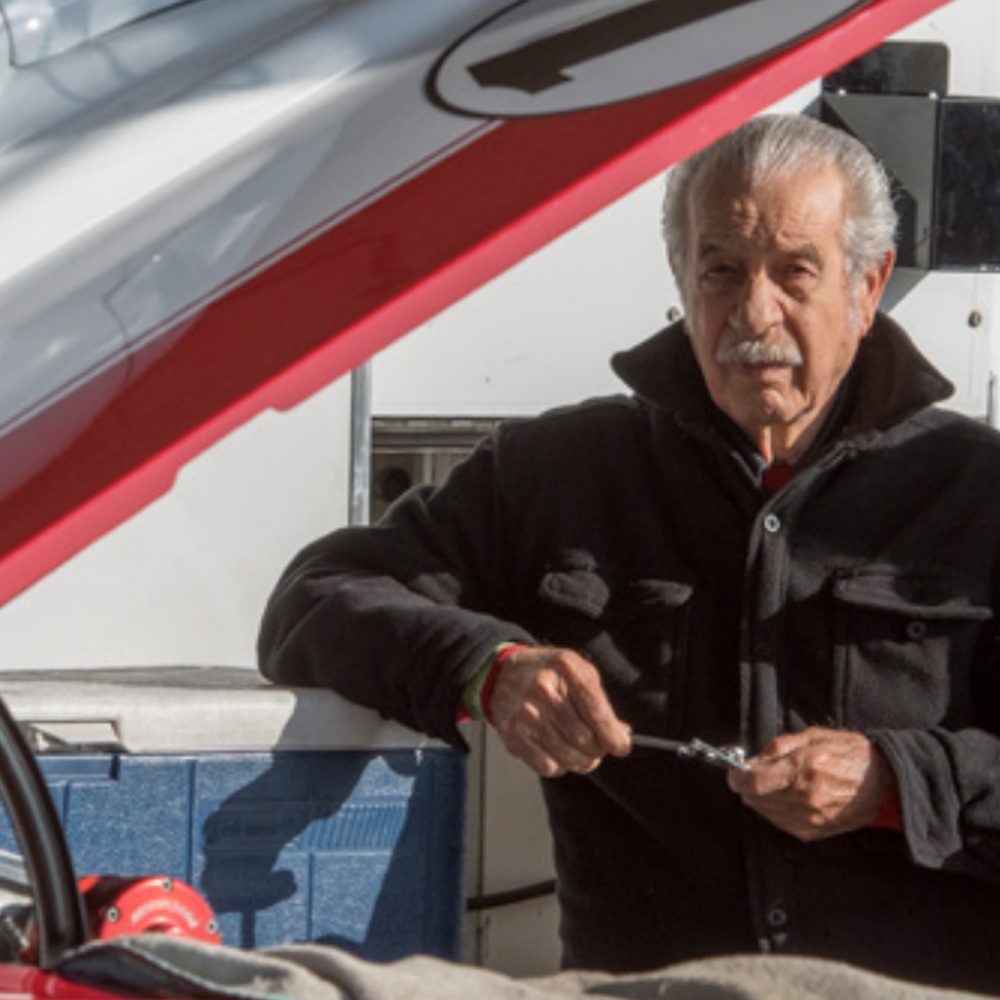Mojave Mile

Runway lights line airport asphalt to guide planes that are touching down or taking off. In the sunrise on the Mojave Air and Space Port; the runway is ready for some big V8 thunder. The team is ready for more high-speed adventures. The tune selector is at full attack mode…Blown ALC! The highest setting for its biggest power plant. RJ likes to take a few minutes in the morning to reflect on the task at hand, which is always to go faster than the last outing. Between every trip to the asphalt, RJ has the guys make some sort of modification to the car. Sometimes it’s small, and sometimes it’s big, but the goal is always to go faster. It wouldn’t be worth the time, effort, and funds required to run for a weekend unless there was an improvement worth testing. The effort required to go an extra mph over 200 is exponential. A significant change in tuning or a modification could net an extra 100 horsepower, but the car may only go from 250 to 252 mph. It’s RJ’s passion for speed and the knowledge that he can rely on his great crew to deliver the goods that keeps Big Red going.
When RJ is all suited up, he knows that it’s only a little while before he swaps his hat for a helmet, and it’s time to get back in Big Red .Larry is always on. He takes his work seriously. He doesn’t sit back and hope others will help. If there’s work to be done on the engine, he’s in there with tools in hand. The rest of the crew treat him with respect. He’s earned it. Before every run, the crew warms up the engine and the drivetrain. Unlike being at a hill climb in a cold climate where all four tires need to be warmed in the trailer, running high speed in a straight line is typically done in a warmer climate, and the most important traction is from the rear tires for the launch and hard acceleration. So the tires stay on for the full warm up for these top speed events. The time lapse shows Big Red running 253.6 mph through the finish-ine flags. The bent-over flags show that the wind is blowing, and it’s a tailwind blowing in Big Red’s favor. Every little bit helps when pushing an aerodynamically challenged ’69 Camaro through the wind at insane speeds. The last time lapse shows the parachutes being deployed to bring RJ and Big Red to a halt so another victory can be celebrated Big Red is towed to the starting line. It’s a rare occasion that RJ would start Big Red in the pits and drive it to the starting line. The little fuel cell hidden in the front fender is built for racing, not for driving to the race and then racing.


Even on a warm day, Big Red brings the heat! The flag allows the official to keep track of the direction the wind is blowing on the runway. The flag has Runway Racing printed on it, so this is one of Big Red’s high-speed attempts at Mojave Air and Space Port to break the 251.8-mph record set by RJ in September 2015. The Runway Racing event should not be mixed up with the Mojave Mile events that previously ran on the same runway. Even though BBS media blasted the tire bead surface of the wheels, the yellow marks on the wheel and the tire show that the Big Red’s tire is slipping on the wheel during hard acceleration. The team may have to resort to drilling the wheels and running rim screws like drag racers. Eric Rhee is in the middle, explaining
how Big Red should act with the new tune.Big Red gets to run with fast company. The planes in the airline graveyard are a dead giveaway that they are at the Mojave Air and Space Port. They don’t fly anymore, but Big Red sure does. After the long rebuild process and some aunch testing at Famoso Raceway in Bakersfield, the crew rolled Big Red off the trailer and warmed it up. RJ took it out for the first run and tripped the lights at the 1.5-mile mark with a blistering 243.1-mph pass — a great first run. The crew was happy with a good baseline upon which to build, but it still had plenty of work to do to break the old record.Going racing is a family affair. Part of the fun is experiencing it with loved ones. The women have been a big part of the Big Red Support team. Toni (left) is there to support Larry. When Tim’s not wrenching on Big Red at the track, he and Jackie (middle) are racing other events and enjoying her awesome new Corvette Z06. Lorna (right) helps Dave pack Big Red’s parachutes and runs support for the team so everyone gets the fuel they need to keep the crew going. With high-speed events at airports comes windy conditions. On the runs sometimes the wind can be with you or against you. Headwinds and crosswinds are a hindrance at best, but a tailwind is great. You never know what you’re going to get until you’re running. Even though Big Red has huge Baer Racing brakes, RJ always deploys the parachutes to make a safe stop at the top end of the tarmac. Depending on the time of year, the wind can be cold. When that’s the case, the guys use Chicken Hawk Racing tire warmers to keep them warm between runs. That way, the rubber is a little more pliable for better traction off the line. Every little bit of help during takeoff is needed when a car like Big Red is attempting to get a few more mph on the top end .The guys step inside the trailer, out of the wind, to discuss how the previous run went and what they might change to improve the next run. It takes a village, and everyone needs to be on the same page to make a positive difference in the outcome Getting a ’69 Camaro to go 250-plus mph isn’t Getting a ’69 Camaro to go 250-plus mph isn’t something that just happens; there are plenty of things that need to be done along the way. At that speed, every part of the car is put to the test. Almost every part of Big Red is custom-built to be as strong as possible. Part of racing is finding out what went wrong and/or what broke on the last run. Even when something is strong, there’s always a weak link.

That’s where Team Big Red comes to the rescue. It knows the Camaro better than anyone else on Earth. Big Red’s head mechanic, Mark Ewing, is always the first to get his hands dirty. But Mark’s not the only one on the team who turns wrenches; everyone helps. When Big Red is running at events in Southern California, the crew on hand is bigger because it’s closer to home. Additional family and friends come to support the team as much as possible. At this event there were some electrical gremlins that were causing trouble with the electronics for the Rossler 4L80E transmission and with the ignition. When Big Red had mechanical problems at the track, the crew won’t simply pack it up and go home. The team does everything in its power to get the most out of the trip. The transmission was swapped with the spare in the trailer. They hoped that the backup transmission will fix the issue.

a ’69 Camaro to go 250-plus mph isn’t something that just happens; there are plenty of things that need to be done along the way. At that speed, every part of the car is put to the test. Almost every part of Big Red is custom-built to be as strong as possible. Part of racing is finding out what went wrong and/or what broke on the last run. Even when something is strong, there’s always a weak link. That’s where Team Big Red comes to the rescue. It knows the Camaro better than anyone else on Earth. Big Red’s head mechanic, Mark Ewing, is always the first to get his hands dirty. But Mark’s not the only one on the team who turns wrenches; everyone helps. When Big Red is running at events in Southern California, the crew on hand is bigger because it’s closer to home. Additional family and friends come to support the team as much as possible. At this event there were some electrical gremlins that were causing trouble with the electronics for the Rossler 4L80E transmission and with the ignition. When Big Red had mechanical problems at the track, the crew won’t simply pack it up and go home. The team does everything in its power to get the most out of the trip. The transmission was swapped with the spare in the trailer. They hoped that the backup transmission will fix the issue.
.The guys step inside the trailer, out of the wind, to discuss how the previous run went and what they might change to improve the next run. It takes a village, and everyone needs to be on the same page to make a positive difference in the outcome Getting a ’69 Camaro to go 250-plus mph isn’t Getting a ’69 Camaro to go 250-plus mph isn’t something that just happens; there are plenty of things that need to be done along the way. At that speed, every part of the car is put to the test. Almost every part of Big Red is custom-built to be as strong as possible. Part of racing is finding out what went wrong and/or what broke on the last run. Even when something is strong, there’s always a weak link. That’s where Team Big Red comes to the rescue. It knows the Camaro better than anyone else on Earth. Big Red’s head mechanic, Mark Ewing, is always the first to get his hands dirty. But Mark’s not the only one on the team who turns wrenches; everyone helps. When Big Red is running at events in Southern California, the crew on hand is bigger because it’s closer to home. Additional family and friends come to support the team as much as possible. At this event there were some electrical gremlins that were causing trouble with the electronics for the Rossler 4L80E transmission and with the ignition.


When Big Red had mechanical problems at the track, the crew won’t simply pack it up and go home. The team does everything in its power to get the most out of the trip. The transmission was swapped with the spare in the trailer. They hoped that the backup transmission will fix the issue.The newly installed backup transmission is in, and Tim and Mark worked quickly to reinstall the transmission safety blanket; Jerry Cornelison and Cliff reassemble the serviceable transmission tunnel cover inside the car. Dave is standing over the fender and filling the transmission with new fluid. Once the backup transmission and torque converter were installed, it was time to make another pass. The newly installed backup transmission is in, and Tim and Mark worked quickly to reinstall the transmission safety blanket; Jerry Cornelison and Cliff reassemble the serviceable transmission tunnel cover inside the car.
Dave is standing over the fender and filling the transmission with new fluid. Once the backup transmission and torque converter were installed, it was time to make another pass. The torque converter was locking up correctly, but needed a little tuning to get it to lock up sooner. When attempting to get a new record pass, parts swapping and adjustments are normal. The guys know that they will be busy all day, from the first run in the morning until the first few minutes of the event. Wind-tunnel testing showed that Big Red’s rear spoiler could be raised to the top adjustment hole for more downforce without creating excessive drag. Tim and Jerry work on adding an “L” channel to the rear edge of the spoiler, and they’re going to increase the spoiler’s angle After a few runs, the transmission fluid smelled as if it was burning, so the fluid was changed again. They don’t want to take any chances running questionable fluid. The team only uses Amsoil synthetic Super Shift fluid in the Rossler Transmisssions 4L80E transmission. They always stick to what the manufacturer suggests. Rossler knows exactly what works best in its products.
